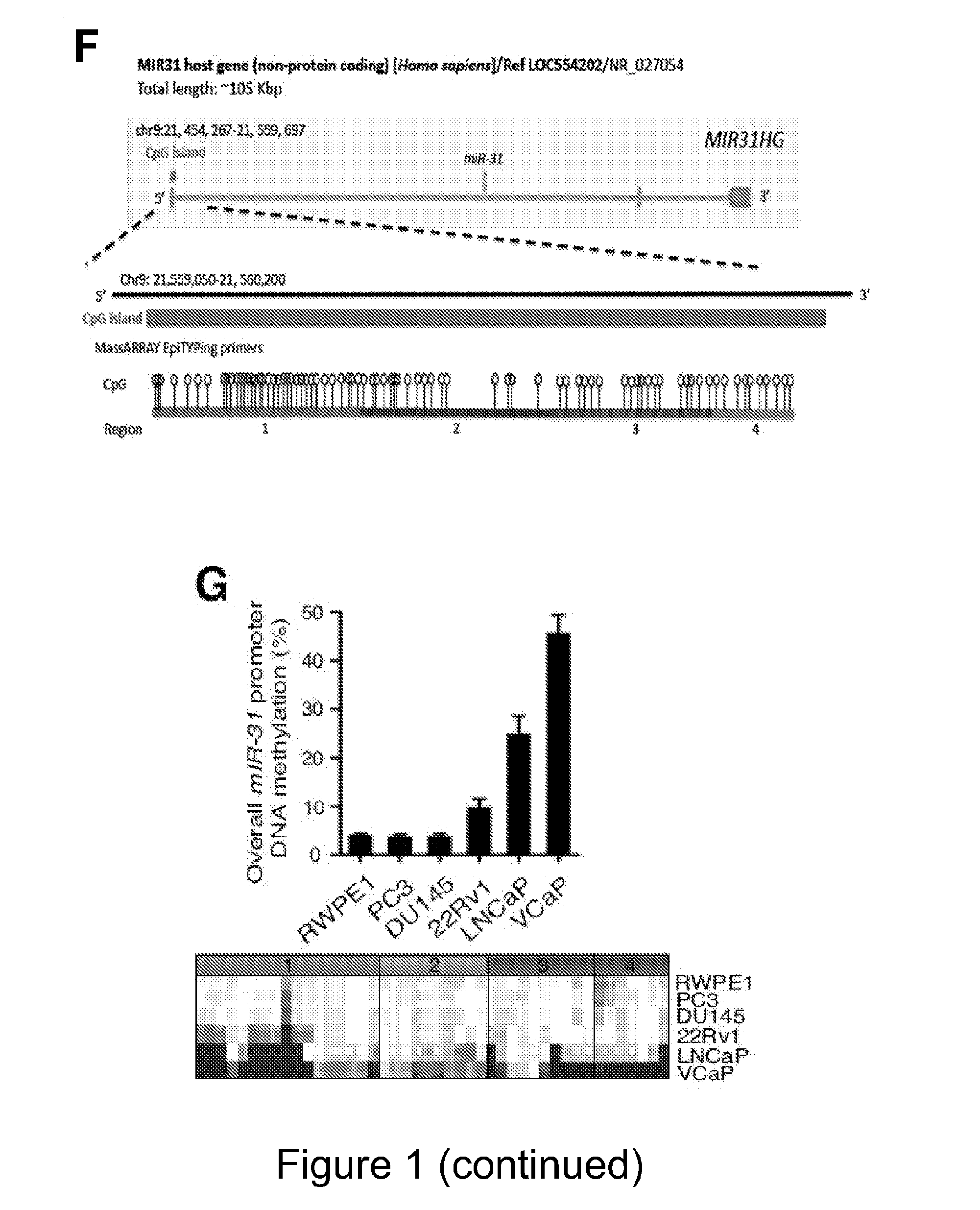MiRNA-31 AS A DIAGNOSTIC, PROGNOSTIC AND THERAPEUTIC AGENT IN CANCER
a cancer and prognostic agent technology, applied in the field of identification, treatment and characterization of cancer, can solve the problems of short-lived beneficial effect of adt, large public health problem of prostate cancer, and often perturbed processes, so as to reduce the expression level of mir-31 and inhibit the activity of ar
- Summary
- Abstract
- Description
- Claims
- Application Information
AI Technical Summary
Benefits of technology
Problems solved by technology
Method used
Image
Examples
example 1
MiR-31 Expression is Suppressed in PCA
[0113]Here, the inventors interrogated 21 pairs of primary PCA and matched benign prostate tissue. 105 miRNAs were identified as significantly altered in PCA (FDR-adjusted p value <0.05, Table 1), including 25 miRNAs with at least 1.5-fold expression change (FIG. 1A; Table 2). The data showed upregulation of miR-182 and miR-375 and downregulation of miR-31, miR-145, miR-205, miR-221, and miR-222 in PCA.
[0114]The inventors then verified miR-31 expression in 14 of the 21 matched pairs, and 93% (13 / 14) showed decreased miR-31 expression in PCA with respect to matched benign prostate tissue (FIG. 1B). MiR-31 is located in the intronic region of its host gene MIR31HG (RefSeq NR—027054). The overall expression of miR-31 and MIR31HG in a cohort of 40 primary PCA specimens was significantly lower as compared to 15 benign prostate tissues (p-value <0.0001, FIG. 1C). Taken together, our data demonstrated the downregulation of miR-31 in primary PCA.
example 2
PCA-Specific Downregulation of miR-31 is Mediated by Promoter Hypermethylation
[0115]To delineate the mechanism behind the downregulation of miR-31 in PCA, the inventors first examined whether genomic (i.e., somatic) loss was responsible. By examining somatic copy number alterations across a variety of tumor types the inventors found that PCA did not have any deletion peaks at the MIR31HG locus (FIG. 1D). The genomic area spanning the MIR31HG locus and adjacent genes was deleted in only a small fraction (2-4%) of individuals with localized PCA. Altogether, the low rate of somatic copy number losses shows that genomic loss does not account for the high frequency of miR-31 downregulation in PCA.
[0116]Next, the inventors examined if epigenetic alterations account for the down-regulation of miR-31 expression. To determine, the inventors evaluated DNA methylation of the promoter region of MIR31HG / miR-31 on 12 matched samples by a direct quantitative DNA methylation assay (MassARRAY EpiTyp...
example 3
MiR-31 Promoter Hypermethylation Correlates with Aggressiveness of PCA
[0118]The inventors then elucidated an association between miR-31 promoter methylation and PCA disease progression. PCA is graded using the Gleason score. A Gleason score ranges from 2-10 and higher scores (i.e. 7-10) are associated with a more aggressive clinical course. Thirty eight (38) primary PCA cases with Gleason scores ranging from 6 to 9 were examined along with 5 metastatic castration resistant PCA cases from patients who failed endocrine therapy and / or developed a predominantly androgen independent PCA associated with lack of AR expression and extensive neuroendocrine differentiation (Gleason scores are not assigned to metastatic PCAs). DNA methylation at the miR-31 promoter was positively correlated with PCA progression (Table 5). The overall DNA methylation at the miR-31 promoter showed significant differences among three groups: Gleason scores 6, ≧7, and metastatic cancer (FIG. 1J), and it was invers...
PUM
| Property | Measurement | Unit |
|---|---|---|
| molecular weight | aaaaa | aaaaa |
| molecular weight | aaaaa | aaaaa |
| molecular weight | aaaaa | aaaaa |
Abstract
Description
Claims
Application Information
 Login to View More
Login to View More - R&D
- Intellectual Property
- Life Sciences
- Materials
- Tech Scout
- Unparalleled Data Quality
- Higher Quality Content
- 60% Fewer Hallucinations
Browse by: Latest US Patents, China's latest patents, Technical Efficacy Thesaurus, Application Domain, Technology Topic, Popular Technical Reports.
© 2025 PatSnap. All rights reserved.Legal|Privacy policy|Modern Slavery Act Transparency Statement|Sitemap|About US| Contact US: help@patsnap.com



